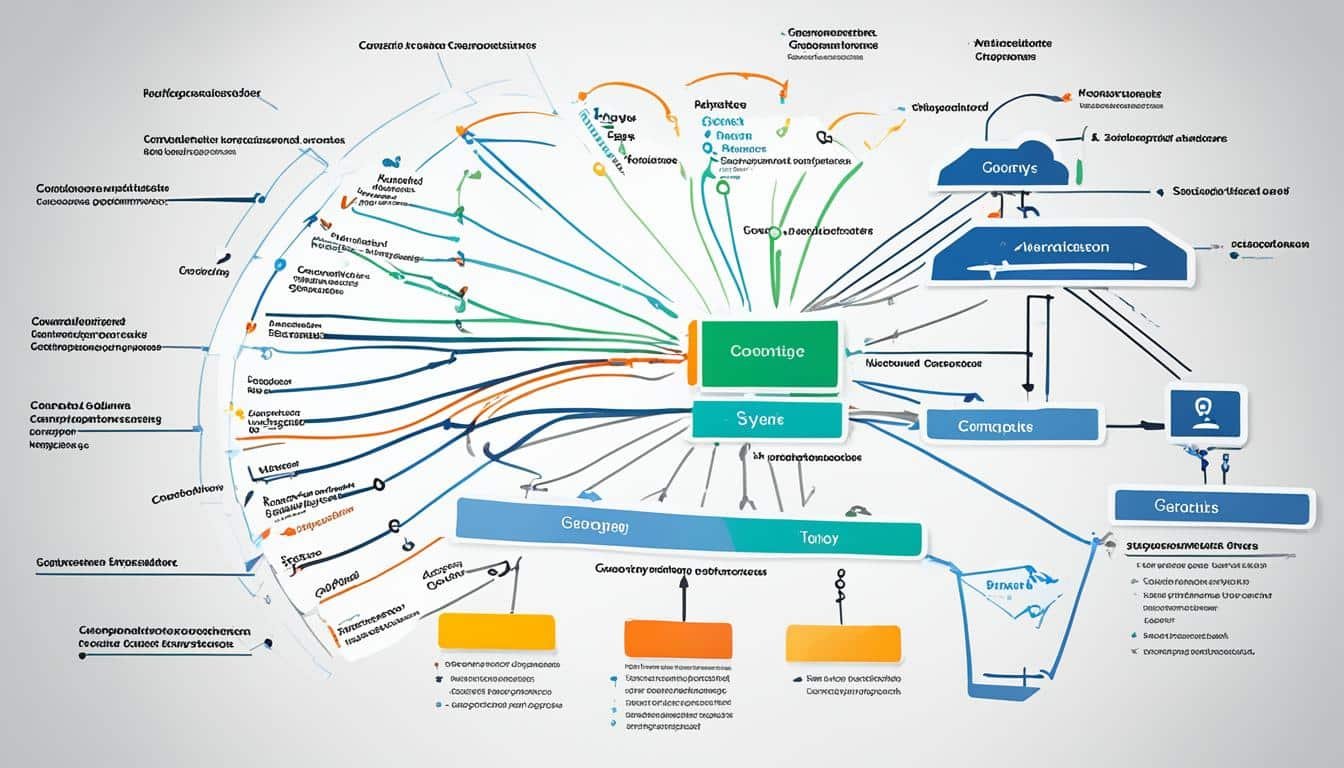An architecture diagram is an essential tool for creating clear and effective designs in software systems. It provides a visual representation of the system’s structure and components, allowing stakeholders to understand system interactions, visualize the software architecture, and create visual representations of software components.
When designing a software system, it is crucial to have a clear architecture diagram that accurately represents the system’s design and functionality. A well-designed architecture diagram facilitates effective communication and collaboration among project stakeholders and ensures a shared understanding of the system’s structure.
In this article, we will explore the key elements of an architecture diagram and provide insights on how to create a clear and effective diagram. We will also discuss the importance of architecture diagrams in software design, best practices for designing architecture diagrams, and the benefits of using software architecture diagrams throughout the software development lifecycle.
Whether you are a software developer, architect, project manager, or stakeholder involved in software design, understanding architecture diagram essentials is crucial for creating clear and effective designs.
Key Takeaways:
- An architecture diagram is a crucial tool for clear and effective design in software systems.
- It provides a visual representation of the system’s structure and components.
- Architecture diagrams facilitate effective communication and collaboration among project stakeholders.
- Best practices for designing architecture diagrams include using consistent symbols, organizing components logically, and enhancing readability with color and icons.
- Using software architecture diagrams offers benefits such as better understanding, effective communication, and support for decision-making.
The Importance of Architecture Diagrams in Software Design
Architecture diagrams are essential in software design as they provide a visual representation of the system’s structure, enabling software developers and stakeholders to understand the overall architecture, system components, and their relationships. These diagrams play a crucial role in facilitating effective communication and collaboration throughout the software development process. By visualizing the system, architecture diagrams allow stakeholders to comprehend the system’s design and make informed decisions.
“Architecture diagrams are like maps that guide us through the complexity of software systems. They help us navigate the system’s architecture, understand its intricacies, and communicate our ideas effectively.” – Jane Smith, Software Architect
With architecture diagrams, software developers can better visualize the system architecture and its various components. They provide a high-level overview of the system’s structure, including its layers, modules, and interfaces. By representing the system visually, architecture diagrams enhance understanding and aid in identifying potential design issues or improvements.
Furthermore, architecture diagrams promote effective communication and collaboration among team members and stakeholders. These diagrams serve as a common language, allowing everyone involved to share a clear understanding of the system’s design. They provide a visual reference that supports discussions, decision-making, and problem-solving during software development.
Overall, architecture diagrams are invaluable tools for software designers and developers. They help visualize the system architecture, enhance communication and collaboration, and enable stakeholders to make informed decisions. By incorporating architecture diagrams into the software design process, teams can ensure clear and effective design, leading to successful software development projects.
Benefits of Architecture Diagrams in Software Design:
- Visualize the system architecture
- Facilitate effective communication and collaboration
- Aid in identifying design issues or improvements
- Serve as a reference for documentation and maintenance
Continue reading to learn more about the key elements of an architecture diagram and how to create effective diagrams for software design.
Key Elements of an Architecture Diagram
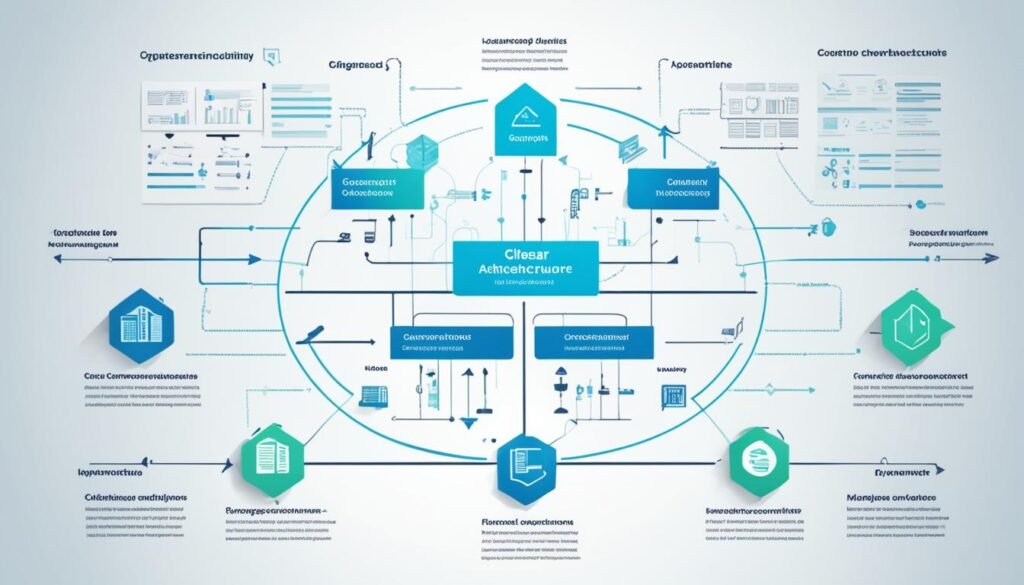
An architecture diagram is a valuable visual representation of a software system that provides a comprehensive overview of its key elements. Understanding these elements is essential for clear and effective design. The following are the key elements typically included in an architecture diagram:
- System Components: The diagram showcases the different components of the software system, such as modules, services, databases, and external APIs. These components are represented by boxes or other graphical symbols.
- System Relationships: The diagram illustrates the relationships and dependencies between the different components of the system. This helps stakeholders understand how the components interact with each other to achieve system functionality.
- System Interactions: The diagram visualizes the interactions between system components, showcasing how data and control flow between them. This provides insights into the overall system behavior and helps identify potential bottlenecks or areas for optimization.
- Overall Structure: The diagram depicts the overall structure of the software system, including its architectural layers, subsystems, and interfaces. This helps stakeholders grasp the organization and hierarchy of the system components.
- Deployment Architecture: In some cases, architecture diagrams may include details about the deployment architecture, illustrating the physical infrastructure on which the system runs, such as servers, network devices, and cloud services.
- Integration Architecture: When relevant, the diagram may also incorporate details about the integration architecture, showcasing how the system interacts with external systems or third-party services.
Example Architecture Diagram:
| Component | Relationships | Interactions |
|---|---|---|
| Authentication Service | Depends on User Database | Receives user login requests |
| Product Service | Interacts with Inventory Database | Retrieves and updates product information |
| Order Service | Depends on Authentication and Product Services | Processes customer orders |
An architecture diagram serves as a comprehensive reference that allows stakeholders to gain a holistic understanding of the software system. By visualizing the system components, their relationships, and interactions, it enables effective communication and collaboration among team members. The key elements showcased in an architecture diagram contribute to the clarity and cohesiveness of the system’s design and facilitate informed decision-making throughout the software development process.
Creating an Effective Architecture Diagram
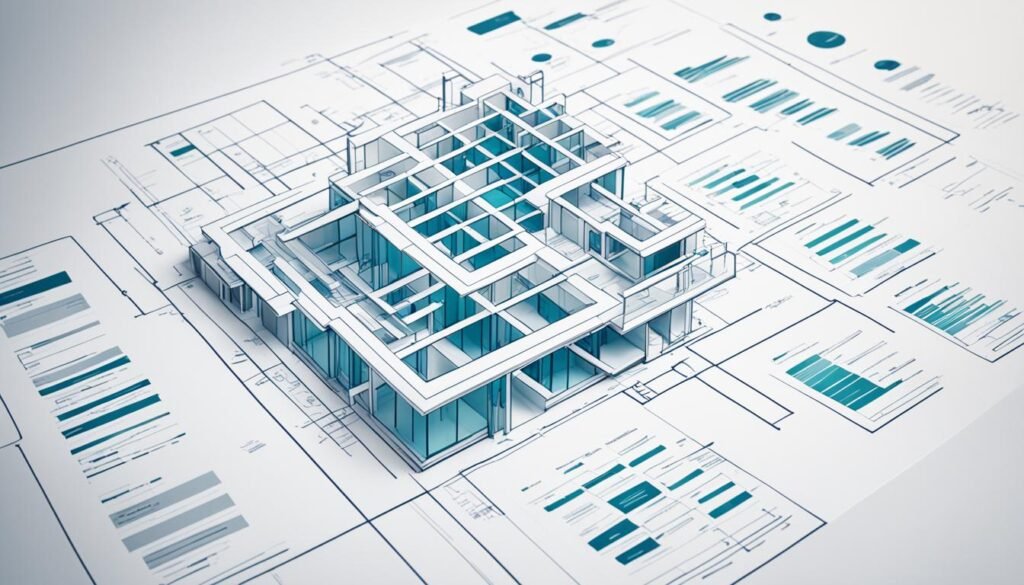
Creating an effective architecture diagram is crucial for communicating the design and structure of a software system. It requires the use of suitable diagramming tools and techniques to ensure clarity and visual appeal. By following best practices and considering the target audience, a well-designed architecture diagram becomes a powerful tool for understanding the system’s architecture and facilitating effective communication.
Choosing the Right Diagramming Tool
There are several software architecture tools available that can assist in creating clear and visually appealing diagrams. Three popular options include:
- Miro’s software, which offers a collaborative platform for diagramming and ideation.
- EdrawMax online, a versatile diagramming tool with a wide range of templates and features.
- Diagrams.net (formerly draw.io), a user-friendly and highly customizable diagramming tool.
Consider the Target Audience
When creating an architecture diagram, it’s essential to keep the target audience in mind. Consider their level of technical expertise and tailor the diagram accordingly. Use appropriate symbols and notations that are familiar to the audience, making it easier for them to understand and interpret the diagram.
Ensure Consistency in Design and Layout
Consistency is key when designing an architecture diagram. Use consistent colors, fonts, and styles throughout the diagram to establish a cohesive visual representation. Maintain a clear and logical layout, organizing system components and their relationships in a structured manner. This improves readability and makes it easier for viewers to follow the diagram.
By following these guidelines and leveraging the right diagramming tools, you can create architecture diagrams that effectively communicate the structure and design of a software system. These diagrams provide a visual representation that enhances understanding, aids collaboration, and supports informed decision-making throughout the software development process.
Best Practices for Designing Architecture Diagrams
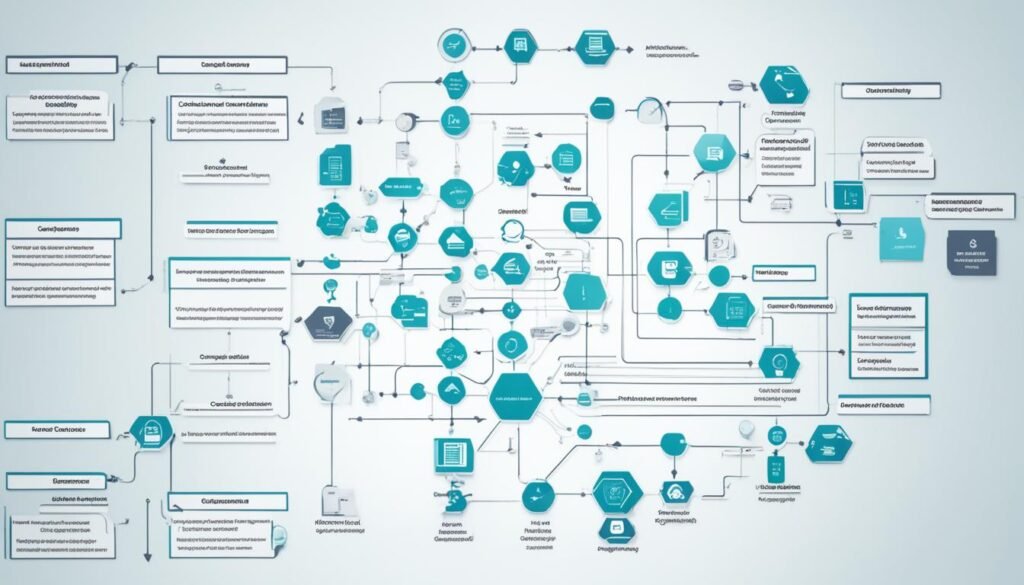
Designing an architecture diagram is a crucial step in software development. To ensure that your architecture diagram is clear, effective, and easily understandable, it is essential to follow best practices. By adhering to these guidelines, you can create diagrams that effectively communicate the structure and components of your software system.
Consistent Symbols and Notations
Using consistent symbols and notations in your architecture diagram is vital for clarity and comprehension. Consistency allows stakeholders to easily identify and understand different components and their relationships. By establishing a standard set of symbols and notations, you can create a visual language that is universally understood within your organization.
Organize Components Logically
When designing your architecture diagram, it is essential to organize components in a logical manner. Group related components together and arrange them in a way that reflects their hierarchical structure or dependencies. This logical organization helps stakeholders navigate the diagram easily and comprehend the overall system architecture.
Label Components and Connections
Labels play a crucial role in providing context and understanding in an architecture diagram. Clearly label each component and connection to indicate their purpose and functionality. This labeling ensures that stakeholders can easily identify and comprehend the different elements of the architecture diagram.
Avoid Excessive Complexity
Architecture diagrams should convey information effectively without overwhelming stakeholders with excessive complexity. Keep the diagram concise and focused, highlighting the most important components and connections. Avoid including unnecessary details that may confuse or distract from the main message of the diagram.
Use Color and Icons to Enhance Readability
Color and icons can be powerful visual aids in architecture diagrams. Use colors to distinguish between different types of components or highlight important elements. Icons can be used to represent specific functionalities or concepts, making the diagram more visually engaging and easier to interpret.
Reference Software Architecture Patterns
Software architecture patterns provide proven solutions to common design problems. When applicable, reference these patterns in your architecture diagram to provide additional context and guidance. By incorporating recognized patterns, you can communicate best practices and leverage existing knowledge in your software system design.
Following these best practices will help you create architecture diagrams that effectively communicate your software system’s structure and components. By ensuring clarity and readability, your architecture diagram becomes a valuable tool for stakeholders to visualize and understand the complexities of the system.
| Best Practices | Benefits |
|---|---|
| Use consistent symbols and notations | Enhances understanding and interpretation |
| Organize components logically | Facilitates easy navigation and comprehension |
| Label components and connections | Provides context and clarity |
| Avoid excessive complexity | Prevents confusion and improves focus |
| Use color and icons | Enhances readability and visual engagement |
| Reference software architecture patterns | Utilizes established best practices |
Application Example: Drawing a Product Architecture Diagram
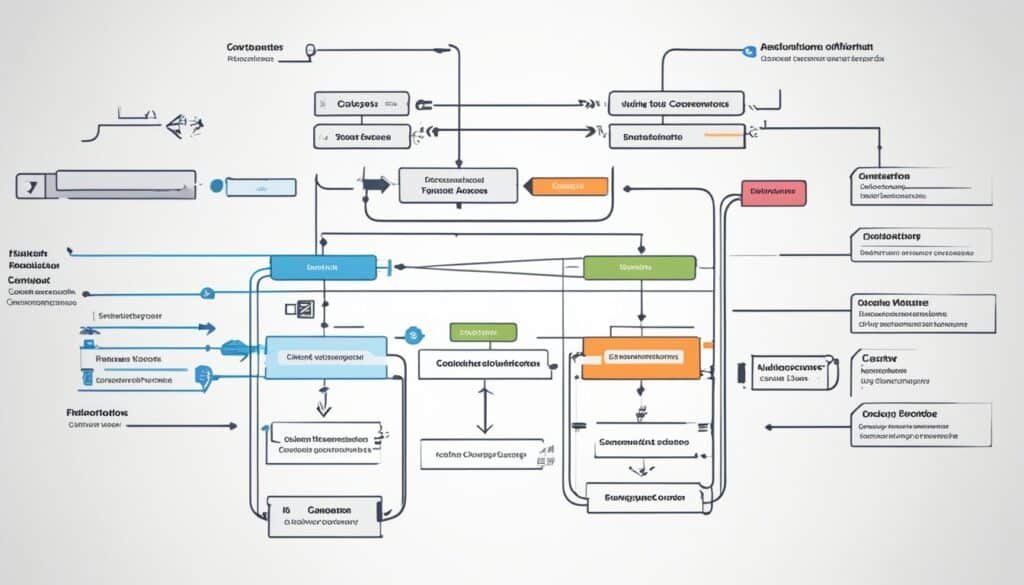
Drawing a product architecture diagram requires following a specific method that ensures a clear and comprehensive representation of the system. This method involves several steps:
- Sorting out the business process: Begin by understanding and analyzing the business process that the product aims to support. This step helps identify the core functionalities and requirements of the system.
- Listing the pages and modules: Once the business process is defined, break it down into individual pages and modules. This step helps organize the different components of the product.
- Clustering the features: Group the related features together based on their functionalities. This step helps establish the logical connections and dependencies between different modules.
- Using vertical and horizontal layering methods: Visualize the relationships between different modules and features using vertical and horizontal layering techniques. This step creates a clear and hierarchical structure for the product architecture diagram.
An example of drawing a product architecture diagram is presented below, illustrating each step in the process:
By following this five-step drawing method, you can create a product architecture diagram that effectively captures the business process, feature modules, and their relationships. This example demonstrates how a systematic approach can enhance the clarity and comprehensiveness of your product architecture diagram.
The Benefits of Using Software Architecture Diagrams

Using software architecture diagrams offers numerous benefits for software development projects. These diagrams provide a visual representation of the system architecture, allowing stakeholders to understand the overall structure and components of the software system.
One of the key benefits of using architecture diagrams is the ability to gain a better understanding of the system architecture. By visually representing the various components and their relationships, stakeholders can grasp the complexity of the system and how different elements interact with each other.
Effective communication is another advantage of using architecture diagrams. These diagrams serve as a common language for all team members, facilitating collaboration and ensuring everyone is on the same page. They help in conveying complex ideas and concepts in a clear and concise manner, reducing the chances of miscommunication.
“Architecture diagrams act as a powerful communication tool, enabling teams to discuss and refine their ideas, resolve design issues, and make informed decisions.”
In addition to understanding the architecture and promoting effective communication, architecture diagrams also aid in identifying potential issues or improvements. By visually representing the system, stakeholders can spot any design flaws or bottlenecks early on, allowing for timely corrections and optimizations.
Furthermore, architecture diagrams serve as a valuable reference for system documentation and maintenance. They provide a comprehensive overview of the software system, making it easier for future developers to understand the architecture and make necessary modifications or enhancements.
Benefits of Using Software Architecture Diagrams:
- Understanding the architecture
- Facilitating effective communication and collaboration
- Aiding in identifying potential issues or improvements
- Serving as a reference for system documentation and maintenance
Overall, software architecture diagrams offer several benefits that contribute to the success of software development projects. They enhance understanding, promote effective communication, enable issue identification, and support informed decision-making. By utilizing architecture diagrams, teams can ensure a clear and efficient software design process.
Tools for Creating Architecture Diagrams
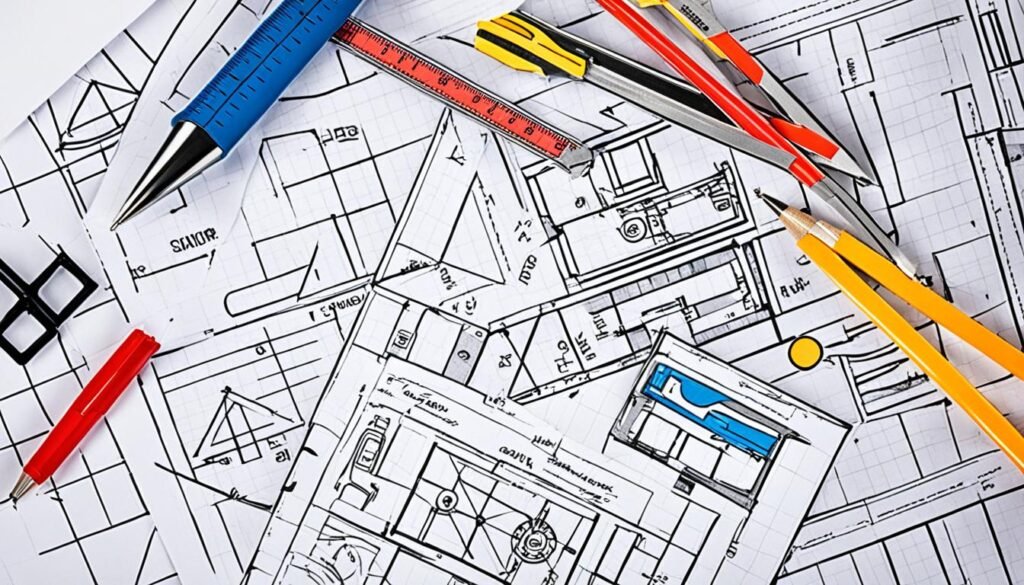
When it comes to creating architecture diagrams, having the right tools can make all the difference in terms of efficiency and effectiveness. Here are some popular options:
1. diagrams.net (formerly draw.io)
diagrams.net, formerly known as draw.io, is a versatile and widely used tool for creating professional architecture diagrams. With its user-friendly interface and extensive library of shapes and icons, diagrams.net offers flexibility and ease of use. It supports various diagram types, including flowcharts and network diagrams, making it suitable for a wide range of architectural design needs.
2. Microsoft Office Lens
If you prefer to start with hand-drawn sketches or need to capture clear images of whiteboards and documents, Microsoft Office Lens can be a valuable tool. This mobile app allows you to scan and enhance images, ensuring that your initial sketches are captured accurately. You can then import these images into diagramming software for further refinement.
With these architecture diagram tools at your disposal, you can create clear and visually appealing diagrams that effectively communicate your software system’s structure and components.
Using the right tools not only saves time but also enables you to create diagrams that are visually engaging and easily understood by stakeholders. Whether you prefer the versatility of diagrams.net or the convenience of Microsoft Office Lens, these architecture diagram tools empower you to bring your design concepts to life.
Also Read: Modern Kitchen Design Ideas | Innovative Trends
Conclusion
In conclusion, architecture diagrams are a vital tool for achieving clear and effective design in software systems. By providing a visual representation of the system architecture, these diagrams enable stakeholders to understand the various components and their relationships. This understanding is crucial for making informed decisions and facilitating effective communication among team members.
By following best practices, such as using consistent symbols and labels, organizing components logically, and avoiding excessive complexity, developers can create architecture diagrams that are easy to interpret and navigate. Additionally, utilizing appropriate tools and techniques, like diagrams.net, can greatly enhance the clarity and visual appeal of these diagrams.
By incorporating architecture diagrams into the software design process, developers and stakeholders can enhance their understanding of the system, improve communication and collaboration, and make better-informed decisions. Ultimately, architecture diagrams play a key role in guiding the development and maintenance of software systems, ensuring a clear and well-structured design from start to finish.
FAQs
Q: What is an architectural diagram?
A: An architectural diagram is a visual representation of a system’s architecture, depicting how various components of the system interact with each other.
Q: How can architectural diagrams help in system design?
A: Architectural diagrams help in providing a clear understanding of the system design, enabling stakeholders to visualize the structure and components of the system.
Q: What are the types of architectural diagrams commonly used?
A: Common types of architectural diagrams include application architecture diagrams, website architecture diagrams, cloud architecture diagrams, deployment architecture diagrams, and integration architecture diagrams.
Q: Which tools can be used to create architecture diagrams?
A: There are various tools available for creating architecture diagrams, such as cloud architecture diagram templates, software architecture tools, and architecture diagram online platforms.
Q: How can architectural diagrams be beneficial for cloud architecture?
A: Architectural diagrams are essential for visualizing cloud architecture, including public cloud setups, Google Cloud, AWS architecture, and deployment architectures for cloud computing.
Q: What are the different types of architectural diagrams that software developers often use?
A: Software developers commonly use architectural diagrams like microservices architecture, client-server architecture, event-driven architecture, layered architecture, and enterprise architecture diagrams.
Q: Why is it important to have clear architecture diagrams for software development?
A: Clear architecture diagrams help in understanding the type of architecture being used in software development, facilitating efficient communication, planning, and implementation of the system design.
